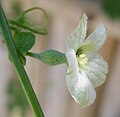Momordica balsamina
| Momordica balsamina | ||||||||||||
|---|---|---|---|---|---|---|---|---|---|---|---|---|

Momordica balsamina |
||||||||||||
| Systematics | ||||||||||||
|
||||||||||||
| Scientific name | ||||||||||||
| Momordica balsamina | ||||||||||||
| L. |
Momordica balsamina , including balsam apple , balsam cucumber , Balsam pumpkin , balsam or wonder apple called, is a plant of the genus Momordica charantia ( Momordica ) within the family of Cucurbitaceae (Cucurbitaceae). It occurs in sub- Saharan Africa .
description
Vegetative characteristics
Momordica balsamina is a climbing, annual to perennial herbaceous plant . The stem , up to 5 meters long, is thin, angular and slightly hairy. The whole plant has a bad smell and contains a pungent juice.
The alternate leaves are arranged in a petiole and a leaf blade. The hairy petiole is short. The soft, thin leaf blade is up to 12 centimeters in size, heart-shaped and broadly ovate to rounded in outline. The sparsely hairy leaf blade is divided in the shape of a hand and five- to seven-lobed and the leaf lobes are each lobed several times or toothed away. The leaf margins are whole and often pointed on the tips of the lobes or teeth. The thin tendrils are simple and long.
Generative characteristics
Momordica balsamina is monoecious gemischtgeschlechtig ( monoecious ). The sometimes long-stalked flowers appear individually, on each side over a bract .
The single flowers are five-fold with a double flower envelope . The finely hairy calyx is five-lobed. The corolla is white or yellow.
The female flowers are stalked short, the ovary is inferior and single chamber and slightly below the calyx (epiperigyn). The stylus is dreiästig with a split scar per branch. Staminodes may be present. The male flowers are stalked longer and have five, three united, fused stamens , with feathery and knotty anthers. At the bottom of the stamens, appendages can be formed on the inside.
The leathery berries (armored berries , pepo), which are red or orange-colored when ripe , are pointed and bumpy, with a length of 4.5 to 7 centimeters, ellipsoidal and short beaked . When the fruit ripens, the fruits open into three lobes and release the many seeds. The elliptical and brownish, sculpted seeds are up to about 1 centimeter in size and are each encased in a red, sticky seed coat “pulp” (false aril ).
The number of chromosomes is 2n = 22.
Occurrence
Momordica balsamina is native to sub-Saharan Africa . It is also cultivated in India and Pakistan, and it was also introduced in the Neotropics . It grows in rather drier regions.
Taxonomy
The first publication of Momordica balsamina was made in 1753 by Carl Linnaeus in Species Plantarum , 2, page 1009. synonyms for Momordica balsamina L. are: Momordica garriepensis Arn. , Momordica huberi death. , Momordica involucrata E. Mey. ex Sond. , Momordica schinzii Cogn. ex Schinz , Nevrosperma cuspidata Raf.
use
The fruits and leaves can be used cooked. The red “pulp” is eaten. The ripe fruits are said to be poisonous.
The fruits, seeds and leaves are used medicinally. The fruits and leaves are used as a soap substitute. The sap can be used medicinally or as a metal cleaner, and it is also used to make arrow poison .
literature
- GJH Grubben, OA Denton: Plant Resources of Tropical Africa. 2: Vegetables , PROTA, 2004, ISBN 90-5782-147-8 , p. 384 f.
- Eduard Winkler : Complete real lexicon of medicinisch-pharmaceutischen and raw goods. Second volume: M – Z , Brockhaus, 1842, p. 73.
Web links
- Momordica balsamina at Useful Tropical Plants , accessed October 27, 2018.
Individual evidence
- ^ Wilhelm Ulrich: International dictionary of plant names. Schmidt, 1872, p. 145, archive.org .
- ↑ Mienkie Welman, 2004: Data sheet - Momordica balsamina at PlantzAfrica , last accessed on November 20, 2018.
- ^ OP Sharma: Plant Taxonomy. Second Edition, Tata McGraw-Hill, 2009, ISBN 978-0-07-014159-9 , pp. 330 f.
- ↑ M. Percival: Floral Biology. Corr. Edition, Pergamon Press, 1969, 1979, ISBN 0-08-010609-9 , p. 37.
- ^ EJH Corner: The Seeds of Dicotyledons. Volume 1, Cambridge Univ. Press, 1976, ISBN 0-521-20688-X , p. 115.
- ↑ Data sheet - Momordica balsamina at Plants of the World online by Kew Science with photos and distribution , last accessed on November 20, 2018.




